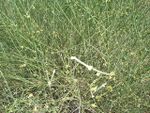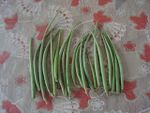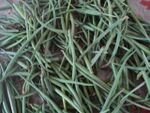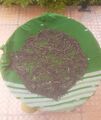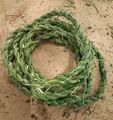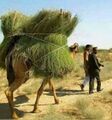Khimp
| Author:Laxman Burdak, IFS (R) |
Khimp (Hindi: खींप; Punjabi: ਖਿੱਪ) is desert herb of the family Apocynaceae. Leptadenia pyrotechnica is the botanical name of this plant. It is widespread from Senegal to India.[1] It is known as khimp in Hindi and Urdu, and khipp in Punjabi.[2]
Being highly drought-resistant, Leptadenia pyrotechnica has played an important role in the desert afforestation programs. The herb khimp is a strong soil binder and, as such, is one of the pioneer species in sand dune fixation.[3]
Variants of name
- Leptadenia pyrotechnica
- Khimp (Hindi: खींप; Punjabi: ਖਿੱਪ)
- Khimpoli (खींपोळी) - The unripe 'pods' (actually follicles) of this shrub are known in Hindi as Khimpoli (खींपोळी).
- Gunchhala (गूंछला)/Gunthala (गूंथला) - The rope made of fiber from the plant.
Description
Leptadenia pyrotechnica is heavily branched and reaches heights of up to 3 metres. The shrub's long roots reach up to 12 metres below the surface.[4] The leaves of the green to grey-green branches tend to fall off early. When present, they are opposite, sessile, elongated to linear, glabrous and about 2 cm long and 3 mm wide.
The very small, greenish-yellow, hermaphrodite and five-fold, short-stalked flowers with a double inflorescence have a diameter of 2 mm and stand in axillary, small cymous inflorescences. The flowers are fine-haired and have a minimal, fleshy corolla. The two ovaries are on top, whilst the stigma and stamens are fused into a very short gynostegium.
The narrow, many-seeded, green, follicular fruits reach 8–11 cm in length. When ripe (like those of the related milkweeds) they dehisce to liberate pappus-tufted seeds, which are carried off by the wind.[5]
Uses
The plant is used in thatching huts. The unripe 'pods' (actually follicles) of this shrub (known in Hindi as Khimpoli (खींपोळी) which ripen in the month of March, are of medicinal value and are also used as a vegetable. The fibre from the plant is used for making ropes. The plant itself is browsed by all stock, but most especially by camels for which it is considered a good fodder.
A recent review of the literature devoted to the species presented it as possessing antifungal, antibacterial, anticancer, antioxidant, wound healing, anthelmintic, antiatherosclerotic, Lipid-lowering agent, antdiabetic and hepatoprotective properties coupled with other multifarious uses. Almost all parts of the plant are used in the traditional medicinal systems of the various countries in which it grows. [6]
खींप
खींप का वानस्पतिक नाम (लेप्टाडेनिया पाइरोटेकनिका/Leptadenia pyrotechnica) होता है. यह एक रेगिस्तानी आयुर्वेदिक अर्थात एक प्रकार की घास होती है जो विशेष रूप से राजस्थान के रेगिस्तानी हिस्सों में ही पाई जाती है. इसे पंजाबी में खीप कहते हैं.
खींप के औषधीय गुण: खींप को कूटने से जो रस निकलता है वह बहुत पुरानेे अथवा दीर्घकालिक चुभे हुए कांटे अथवा मवाद के अंदर फंसी हुई किसी नुकीली वस्तुु को निकालने के लिए अत्यंत लााभकारी होता है. सामान्य शरीर पर यह रस लगाने से खुजली हो जाती है. इसके जेल का भी प्रयोग किया जाता जिसमें शरीर में खुजलाहट को कम करती हैं और चेेहरे पर चमक लाती है.
पिछले कुछ वर्षों में इसके औषधीय गुणों पर अनुुसंधान से पता लगा है कि यह अनेक तरह के फंगल इन्फेक्शन, केंसर, बेक्टीरिया आदि के उपचार में उपयोगी है. यह रोग प्रतिरोधक क्षमता बढाता है. घाव भरने और मस्सों के उपचार में उपयोगी है. ब्लड-सुगर और मधुमेह को नियंत्रित करता है.
राजस्थान में खींप के सूखने के पश्चात झोंपड़ा बनाने में तथा झाड़ू बनाने में काफी हद तक प्रयोग किया जाता है. आजकल राजस्थान के काफी भागों से खींप विलुप्त हो रहा है.
खिम्पोली की सब्जी: खीम्प के फली को खिम्पोली कहा जाता है. यह फ़रवरी अंत और मार्च के प्रारंभ में कुछ ही दिन मिलती है. सब्जी के लिए खिम्पोली को कच्चा तोड़ना पड़ता है. पकने पर रेसा आ जाता है. इसकी सब्जी और कढ़ी बनाई जाती है जो बहुत स्वादिष्ट व्यंजन है. खिम्पोली को हल्का सा उबाल कर सुखा लिया जाता है जो साल भर सब्जी के लिये काम लिया जा सकता है. इसके सब्जी बनाने से पहले ट्रीटमेंट में कोई विशेष प्रक्रिया नहीं होती है. केवल ऊपर नीचे के कड़े भाग तोड़ देते हैं और कुकर में चार-पांच सिटी मरवा देते हैं. इससे यह कड़ी नहीं रहती. उबली हुई से सीधी सब्जी बना सकते हो या इसको सुखाकर जैसे सांगरी को सुखाया जाता है, उसको संग्रहित किया जा सकता है. संग्रहित से सब्जी बनाने के लिए दोबारा उबालना नहीं पड़ता. केवल उबले हुए पानी में दो घंटे छोड़ दो और उसमें थोड़ी हल्दी डाल दो. इससे वह वापस हरि हो जाएगी उससे आप सब्जी बना लो.
A recent review of the literature devoted to the species Leptadenia pyrotechnica (Khimp) presented it as possessing antifungal, antibacterial, anticancer, antioxidant, wound healing, anthelmintic, antiatherosclerotic, Lipid-lowering agent, antdiabetic and hepatoprotective properties coupled with other multifarious uses. Almost all parts of the plant are used in the traditional medicinal systems of the various countries in which it grows.
Reference: Idrees, Saiba; Qureshi, Rahmatullah; Bibi, Yameen; Ishfaq, Aqsa; Khalid, Nadia; Iftikhar, Anam; Shabir, Anam; Riaz, Iqra; Saboon, Nil; Ahmad, Nabeela (23 July 2016). "ETHNOBOTANICAL AND BIOLOGICAL ACTIVITIES OF Leptadenia pyrotechnica (Forssk.) Decne.: A REVIEW". African Journal of Traditional, Complementary and Alternative Medicines. 13 (4): 88–96. doi:10.21010/ajtcam.v13i4.13. PMC 5566157. PMID 28852724.
Gallery
External links
References
- ↑ Flora of Pakistan, Leptadenia pyrotechnica (Forssk.) Decne. in Ann. Sci. Nat. Ser. 2. 9:269. 1839. Boiss., Fl. Or. 4:63.1879; Bullock in Hutch., Dalziel & Hepper, Fl. W. Trop. Afr. ed. 2.2:98. 1963; Rech. f., Fl. Iran. 73: 16.1970.
- ↑ L. R. Burdak (1982): Recent advances in desert afforestation, Dehradun, p.66
- ↑ L. R. Burdak (1982): Recent advances in desert afforestation, Dehradun, p.66
- ↑ Batanouny, K.H.; Abdel Wahab, A.M. (1 June 1973). "Eco-physiological studies on desert plants". Oecologia. 11 (2): 151–161. Bibcode:1973Oecol..11..151B. doi:10.1007/BF00345129. PMID 28307212. S2CID 11208248.
- ↑ M. Arbonnier: Arbres, arbustes et lianes des zones seches d'Afrique de l'Ouest. CIRAD, Montpellier 2000, ISBN 2-87614-431-X.
- ↑ Idrees, Saiba; Qureshi, Rahmatullah; Bibi, Yameen; Ishfaq, Aqsa; Khalid, Nadia; Iftikhar, Anam; Shabir, Anam; Riaz, Iqra; Saboon, Nil; Ahmad, Nabeela (23 July 2016). "ETHNOBOTANICAL AND BIOLOGICAL ACTIVITIES OF Leptadenia pyrotechnica (Forssk.) Decne.: A REVIEW". African Journal of Traditional, Complementary and Alternative Medicines. 13 (4): 88–96. doi:10.21010/ajtcam.v13i4.13. PMC 5566157. PMID 28852724.
